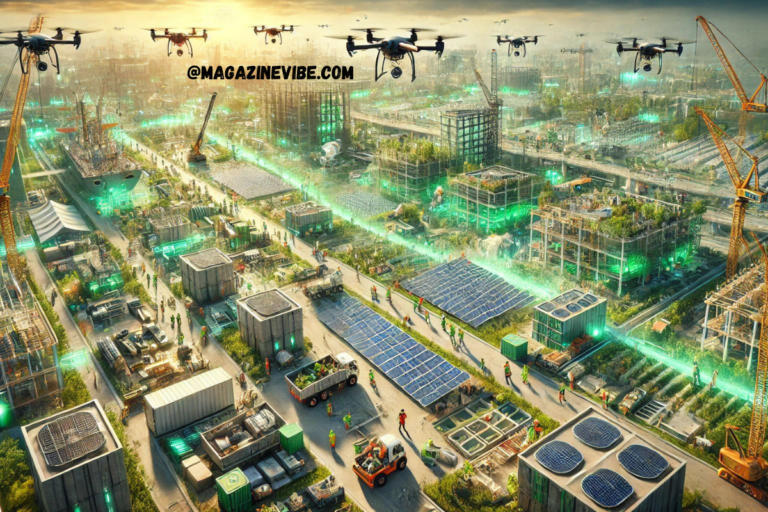Introduction
Stichting Bouwresearch began in 1959. The goal was to improve building methods and use new materials better. Leaders in construction and government came together to start this organization in the Netherlands. They worked on many projects to make buildings safer and more efficient.
Over the years, Stichting Bouwresearch changed its name to SBR and then SBRCURnet. This showed its growth and new focus areas in the construction world.
The mission of SBR was clear: make building in the Netherlands and beyond better through research and new ideas. Their work touched many areas, from how buildings stand up to how energy efficient they can be.
SBR made a big difference in the Dutch construction industry. It helped set standards that builders use today. It also worked with companies around the world to share its findings and learn from others. This way, building methods keep improving, making construction better for everyone.
Mission and Core Objectives
In 1959, Stichting Bouwresearch was set up to make building better. The goals were clear: find new ways to build and use better materials. This focus helped create smarter, safer ways to construct buildings.
Stichting Bouwresearch, later known as SBR, was always about making building more sustainable. This means finding ways to build that are good for our planet and last a long time. They pushed for using new ideas and technologies in building. This has made a big impact on how buildings are made today, making them more environmentally friendly and innovative.
SBR’s work helped change the construction industry. They introduced new standards that made buildings better and safer. This has had a lasting effect on how construction is done, not just in the Netherlands but around the world.
Key Research Initiatives and Innovations
Stichting Bouwresearch has been a leader in developing new building technologies. One of their major innovations is the Sonoblok. This is a special kind of concrete brick made from recycled glass. It’s not only strong but also good for the environment because it stores CO2. This makes buildings better and helps fight climate change.
They also worked on smart building technologies. These are systems that make buildings more efficient. For example, they use less energy and provide a better environment for people inside. This technology is now used in many places, making buildings smarter and greener.
SBR introduced new standards that have changed how buildings are made. These standards are used in the Netherlands and other countries. They help make sure that buildings are safe, efficient, and good for the environment. This has made a big impact on the construction industry worldwide.
Collaborations and Global Influence
Stichting Bouwresearch (SBR) worked with many educational institutions and international organizations. These partnerships helped them share what they learned and pick up new ideas from others. This kind of teamwork is important for making better building methods that can be used around the world.
For example, SBR joined forces with universities to study how buildings can be made safer and more sustainable. These studies helped create new building standards that are now used internationally.
SBR’s work with international bodies also helped spread their knowledge across different countries. This means that the good practices developed in the Netherlands could help improve building in other places too. These collaborations have made a big impact, setting global standards that make buildings everywhere better and safer.
Sustainable Practices and Environmental Impact
Stichting Bouwresearch (SBR) has been a leader in promoting sustainable construction. Their efforts are evident in initiatives like the National Package for Sustainable Reconstruction and the USER-CHI guidelines.
The National Package for Sustainable Reconstruction was designed to rebuild homes and buildings after disasters like earthquakes. This package focuses on using sustainable materials and methods that are not only safe but also environmentally friendly. It helps ensure that the reconstruction efforts lead to communities that are better prepared for future challenges while minimizing environmental impact.
The USER-CHI guidelines were developed to create healthier indoor environments in offices and other buildings. These guidelines focus on user-centered design, which means they take into account how real people use and interact with spaces. By prioritizing health and comfort, these guidelines help ensure that buildings are not only efficient but also promote well-being.
Through these initiatives, SBR has set high standards for sustainability in the construction industry. Their work helps reduce the environmental impact of building projects and leads the way in creating greener, more sustainable communities.
Technological Advancements in Construction
Stichting Bouwresearch (SBR) has effectively integrated cutting-edge technology into the construction sector. Key areas include Building Information Modeling (BIM), digital management, and the development of materials passports.
BIM has been a major focus for SBR, revolutionizing the planning, design, and management of construction projects. BIM technology allows for digital representations of physical and functional characteristics, improving decision-making throughout the building life cycle.
Digital management tools developed by SBR streamline project management and enhance efficiency on construction sites. These tools facilitate better communication and coordination among various project stakeholders, ensuring that projects are completed faster and with fewer errors.
The development of materials passports is another significant technological advance. These passports provide detailed information about the materials used in buildings, including their origins, characteristics, and best methods for reuse and recycling. This initiative supports the circular economy by promoting the use of sustainable materials and enabling easier recycling at the end of a building’s life.
Educational and Training Programs
SBR has also been proactive in preparing the future workforce through various skill development programs and educational initiatives. These programs are designed to equip construction professionals with the latest skills and knowledge in sustainable construction, technology use, and innovative building techniques.
These educational initiatives often involve partnerships with universities and vocational training centers. They focus on practical skills and theoretical knowledge, ensuring that graduates are well-prepared to meet the challenges of the modern construction industry. This approach helps sustain the industry’s growth and encourages continuous improvement and innovation in building practices.
Challenges and Future Outlook
Challenges Faced by SBR Stichting Bouwresearch (SBR) has navigated various challenges, notably economic and regulatory hurdles. Economic challenges include fluctuating funding levels for research and development, which can affect the scope and scale of projects. Regulatory hurdles encompass the evolving standards and codes in the construction industry, which require constant adaptation and compliance. Moreover, integrating new technologies and practices often involves overcoming resistance from within the industry, which can be slow to change.
Future Trends in Construction Influenced by SBR Looking ahead, SBR is poised to play a crucial role in shaping key trends in the construction industry, especially in areas like digital transformation and circular economy practices.
- Digital Transformation: SBR is likely to drive further integration of technologies such as artificial intelligence (AI), machine learning, and continued advancements in BIM. These technologies will enhance the precision, efficiency, and sustainability of construction projects, transforming how buildings are designed, constructed, and managed.
- Circular Economy Practices: SBR’s initiatives around materials passports and sustainable reconstruction packages indicate a strong move towards circular economy practices. This approach not only addresses waste reduction and resource efficiency but also promotes the reuse and recycling of building materials. As global emphasis on sustainability increases, SBR’s work in this area will likely influence international standards and practices, advocating for more resilient and environmentally friendly construction methods.
Conclusion
Stichting Bouwresearch (SBR) has significantly shaped the construction industry through its commitment to research and innovation, particularly in sustainable and technologically advanced building practices. By pioneering initiatives like Sonoblok, smart building technologies, and materials passports, SBR has set new industry standards that promote environmental sustainability and resource efficiency. These efforts have not only transformed construction practices in the Netherlands but also influenced global construction norms, ensuring SBR’s enduring impact on the industry’s evolution towards a more sustainable and efficient future.
FAQs
Q. What was the primary goal of Stichting Bouwresearch when it was established?
SBR aimed to advance construction techniques and materials, focusing on innovation and sustainability in building practices.
Q. How has SBR contributed to sustainable construction?
SBR has pioneered numerous sustainable initiatives, such as the development of eco-friendly materials like Sonoblok and setting industry standards that promote energy efficiency and environmental responsibility.
Q. What significant changes occurred in SBR’s operations over the years?
Originally founded in 1959, SBR evolved its focus and underwent rebranding to SBRCURnet in 2003, reflecting its broader approach to integrating new technologies and sustainable practices in construction.
Q. Can organizations collaborate with SBR on construction projects?
Yes, SBR collaborates with various educational institutions, industry partners, and international bodies to drive innovation and apply research findings practically in the construction industry.
Q. What are some of the key technologies promoted by SBR?
SBR has been instrumental in promoting Building Information Modeling (BIM), smart building technologies, and the development of materials passports to enhance building sustainability and efficiency.
Q. How does SBR influence global construction standards?
Through its research and collaborations, SBR has contributed to setting new benchmarks in construction practices that are adopted internationally, influencing both local and global construction standards.


